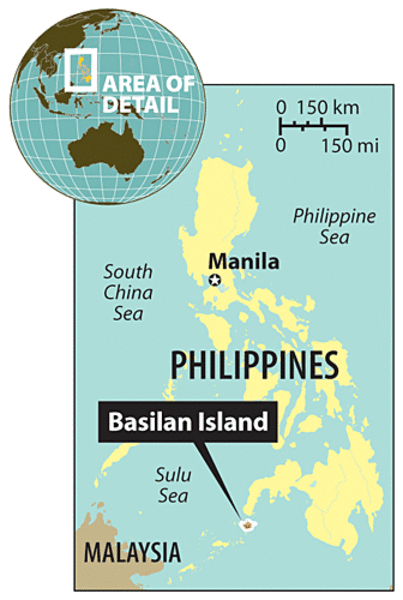In Basilan, Philippines, a US counterterrorism model frays
Loading...
| Manila
Just a couple of years ago, the Philippines was hailed as a success story in the US-led war on terror.
A military campaign by US-backed Philippines Special Forces had routed al Qaeda-linked Abu Sayyaf terrorists from their stronghold in the southern island of Basilan, killed their leaders, and confined surviving diehards to a remote island. Generous economic aid and "hearts and minds" outreach undergirded the "Philippines model."
"The iron fist and the hand of friendship succeeded in ... restoring both peace and hope to the island," crowed an August 2006 State Department report.
But recent violence shows how hard it is to keep the peace, and to uproot terrorists for good. Fighting broke out in Basilan early last week between the Philippines military and Abu Sayyaf. Battles Sunday left five soldiers dead and 24 injured, and reports say some 3,000 civilians have fled their villages amid the violence. The Abu Sayyaf is eyed for a recent spate of kidnappings, the latest of a girl and a nursing student.
How did Basilan flip back into tumult? In an interview last week, one US official explained, "if you withdraw too quickly without leaving appropriate law enforcement to maintain order, you leave a vacuum."
The lesson: terrorists love a vacuum. But in the southern Philippines, it's not clear how much more the government can do. Its resources are already stretched to the limit there fighting a major communist insurgency, hunting "rogue" Muslim rebels, and dealing with a witch's brew of kidnapping gangs, extortionists, gun-runners, and international terrorists in dense jungle terrain. One minor victory: Last week police arrested a suspected bombmaker for Jemmah Islamiyah (JI), the Indonesia-based terror outfit.
More militants 'lurking in the wings'
US officials and analysts say fighting Abu Sayyaf and other terrorists here is a long-term mission with no clear end in sight. They number as many as 200, with another 200 to 400 "lurking in the wings," says Scott Harrison, managing director of Pacific Strategies and Assessments.
"It's immune to destruction. If the [counterterrorism] efforts are successful, their numbers just contract. People bury their weapons, disappear back into the villages, wait for the dust to settle, and then recoup themselves to various degrees. But they are by no means destroyed," he says.
There's no quick fix to the problem, says Mr. Harrison, because Abu Sayyaf and other terrorists are products of decades of policies that aren't easy to reverse.
"These are areas that have suffered from generations of abuse at the hands of the Filipino government and Filipino military," says Harrison. "Poverty, neglect, and abuse is what continues to fuel the Abu Sayyaf Group."
Another US official adds, "You need a concerted effort of hard power and soft power to make up for a century of insecurity and underdevelopment." The US is contributing – $500 million in aid in the last decade, much of it targeted at impoverished Muslim-majority areas in the south.
On the hard-power front, since 2002 the US has trained Philippines Special Forces, provided high-tech equipment like night-vision goggles, and provided an "eye in the sky" for the hunt for terrorists with its unmanned aerial vehicles.
Old grievances persist
But the US can do little to address Muslims' deeply rooted historical and political grievances in the south. That's strictly a job for Manila.
The government tried to take a step in that direction this past summer, with a preliminary deal with the main Muslim rebel group, the Moro Islamic Liberation Front (MILF), to expand a Muslim autonomous area and give it greater control over resources and revenue.
Unfortunately, that peace process collapsed amid violence, recriminations, and a Supreme Court injunction in August. The military is now conducting operations against "rogue" MILF commanders, who have ties with Abu Sayyaf and international terrorists like JI dating back to Afghanistan training camps in the 1970s, according to the International Crisis Group (ICG).
It's not clear if those ties are related to the current activity in Basilan. But a recent ICG report warned, "A few of the Indonesians and Malaysians now working with the Abu Sayyaf might decide to help their beleaguered MILF friends, with or without their endorsement."





